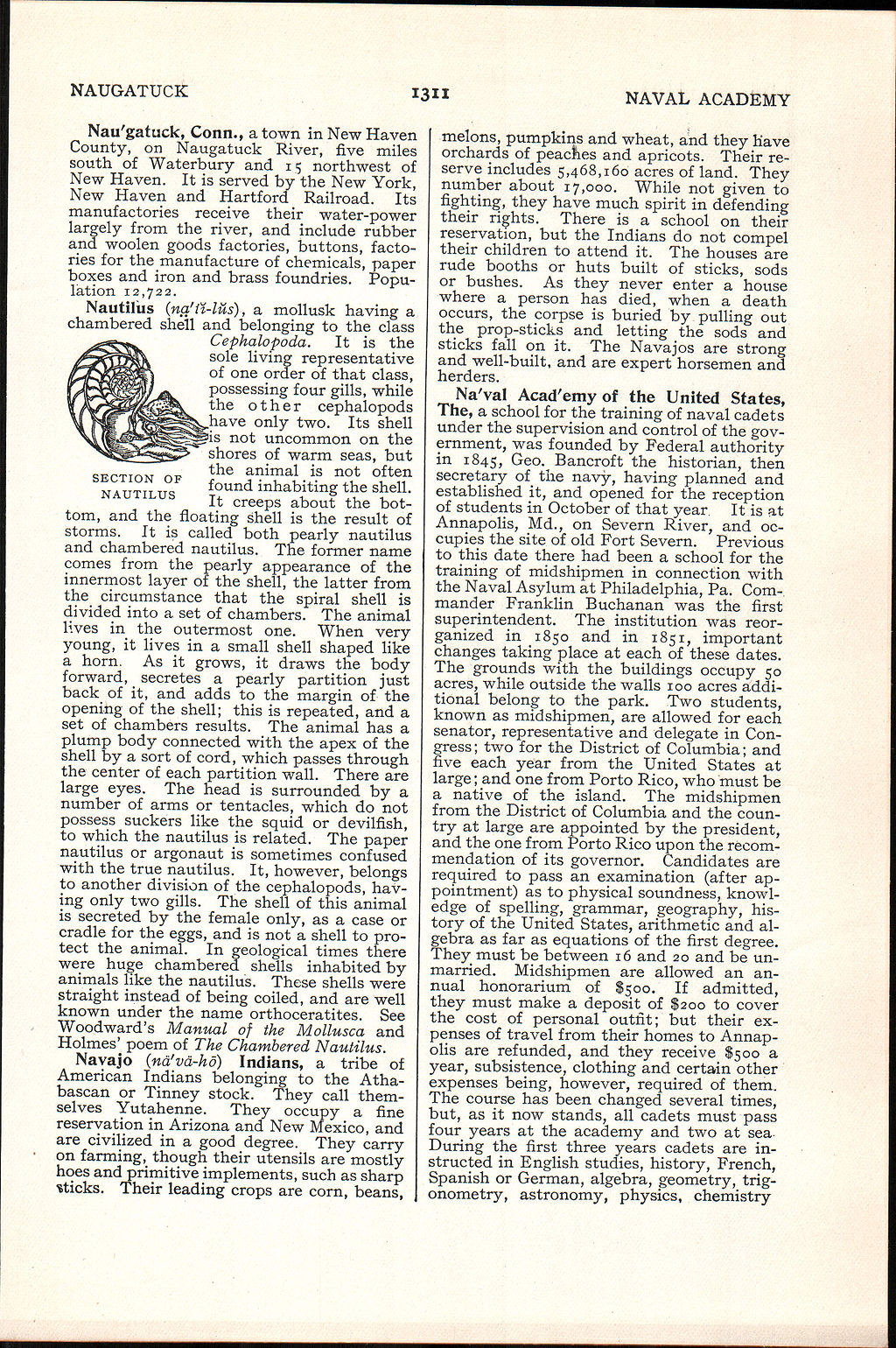Nau′gatuck, Conn., a town in New Haven County, on Naugatuck River, five miles south of Waterbury and 15 northwest of New Haven. It is served by the New York, New Haven and Hartford Railroad. Its manufactories receive their water-power largely from the river, and include rubber and woolen goods factories, buttons, factories for the manufacture of chemicals, paper boxes and iron and brass foundries. Population 12,722.

|
| SECTION OF NAUTILUS |
Nautilus (na̤′tĭ-lŭs), a mollusk having a chambered shell and belonging to the class Cephalopoda. It is the sole living representative of one order of that class, possessing four gills, while the other cephalopods have only two. Its shell is not uncommon on the shores of warm seas, but the animal is not often found inhabiting the shell. It creeps about the bottom, and the floating shell is the result of storms. It is called both pearly nautilus and chambered nautilus. The former name comes from the pearly appearance of the innermost layer of the shell, the latter from the circumstance that the spiral shell is divided into a set of chambers. The animal lives in the outermost one. When very young, it lives in a small shell shaped like a horn. As it grows, it draws the body forward, secretes a pearly partition just back of it, and adds to the margin of the opening of the shell; this is repeated, and a set of chambers results. The animal has a plump body connected with the apex of the shell by a sort of cord, which passes through the center of each partition wall. There are large eyes. The head is surrounded by a number of arms or tentacles, which do not possess suckers like the squid or devilfish, to which the nautilus is related. The paper nautilus or argonaut is sometimes confused with the true nautilus. It, however, belongs to another division of the cephalopods, having only two gills. The shell of this animal is secreted by the female only, as a case or cradle for the eggs, and is not a shell to protect the animal. In geological times there were huge chambered shells inhabited by animals like the nautilus. These shells were straight instead of being coiled, and are well known under the name orthoceratites. See Woodward's Manual of the Mollusca and Holmes' poem of The Chambered Nautilus.
Navajo (nä′vä-hō) Indians, a tribe of American Indians belonging to the Athabascan or Tinney stock. They call themselves Yutahenne. They occupy a fine reservation in Arizona and New Mexico, and are civilized in a good degree. They carry on farming, though their utensils are mostly hoes and primitive implements, such as sharp sticks. Their leading crops are corn, beans, melons, pumpkins and wheat, and they have orchards of peaches and apricots. Their reserve includes 5,468,160 acres of land. They number about 17,000. While not given to fighting, they have much spirit in defending their rights. There is a school on their reservation, but the Indians do not compel their children to attend it. The houses are rude booths or huts built of sticks, sods or bushes. As they never enter a house where a person has died, when a death occurs, the corpse is buried by pulling out the prop-sticks and letting the sods and sticks fall on it. The Navajos are strong and well-built, and are expert horsemen and herders.
Na′val Acad′emy of the United States, The, a school for the training of naval cadets under the supervision and control of the government, was founded by Federal authority in 1845, Geo. Bancroft the historian, then secretary of the navy, having planned and established it, and opened for the reception of students in October of that year. It is at Annapolis, Md., on Severn River, and occupies the site of old Fort Severn. Previous to this date there had been a school for the training of midshipmen in connection with the Naval Asylum at Philadelphia, Pa. Commander Franklin Buchanan was the first superintendent. The institution was reorganized in 1850 and in 1851, important changes taking place at each of these dates. The grounds with the buildings occupy 50 acres, while outside the walls 100 acres additional belong to the park. Two students, known as midshipmen, are allowed for each senator, representative and delegate in Congress; two for the District of Columbia; and five each year from the United States at large; and one from Porto Rico, who must be a native of the island. The midshipmen from the District of Columbia and the country at large are appointed by the president, and the one from Porto Rico upon the recommendation of its governor. Candidates are required to pass an examination (after appointment) as to physical soundness, knowledge of spelling, grammar, geography, history of the United States, arithmetic and algebra as far as equations of the first degree. They must be between 16 and 20 and be unmarried. Midshipmen are allowed an annual honorarium of $500. If admitted, they must make a deposit of $200 to cover the cost of personal outfit; but their expenses of travel from their homes to Annapolis are refunded, and they receive $500 a year, subsistence, clothing and certain other expenses being, however, required of them. The course has been changed several times, but, as it now stands, all cadets must pass four years at the academy and two at sea. During the first three years cadets are instructed in English studies, history, French, Spanish or German, algebra, geometry, trigonometry, astronomy, physics, chemistry
